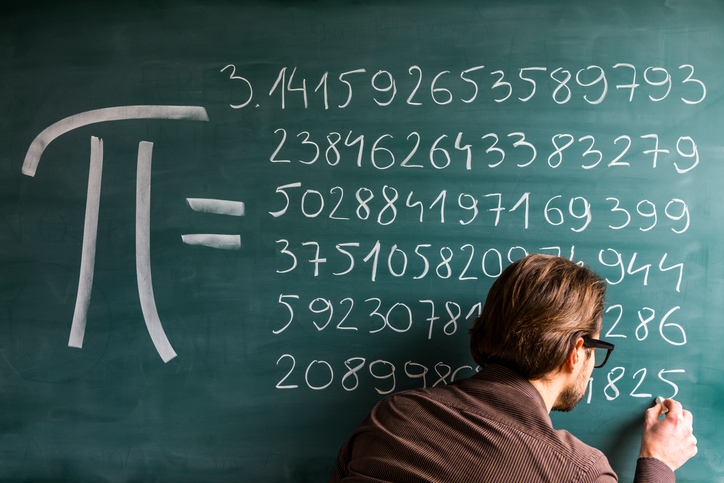
Pi is the world’s most famous irrational number.
It can also prompt people to do some pretty irrational things.
February 6, 1897, was not the brightest hour for my home state of Indiana. That was the day our House of Representatives approved Bill 246, which declared the legal value of pi to be 3.2.
Incredibly, the proposition was titled “A Bill for an Act Introducing a New Mathematical Truth.” But mathematical truths are constants. They cannot be changed by legislatures, Supreme Court rulings, or public referendums. They simply are what they are.
Pi, of course, is the esoteric number that defines every circle. It represents the ratio of a circle’s circumference to its diameter. It is “irrational” because it can be calculated to an extraordinary number of decimal places without any repetition or pattern: 3.141592…and on and on, all the way to at least 62.8 trillion digits, the latest calculation that was announced just this summer. To put it simply, pi is what makes a circle a circle. And that’s that.
Hoosier lawmakers, undeterred, were influenced by the amateur mathematician Edward J. Goodwin, who claimed that 3.2, as the correct value of pi, would make geometry much easier for students.
Kiona Smith, financial historian for Forbes, points out that at first the representatives referred the bill to the Finance Committee, evidently assuming that group was used to dealing with numbers. One skeptic suggested it go to the Committee on Swamplands where it might “find a deserved grave.” Eventually Bill 246 wound up before the Committee on Education, which forever made itself unworthy of that name by approving it and sending it to the floor of the General Assembly for a vote. The representatives promptly voted affirmatively. All that remained was consideration by the Indiana Senate.
Fortunately Clarence Abiathar Waldo, a Purdue math professor, happened to be in Indianapolis on that February day. Waldo, when asked if he wanted to meet the esteemed Edward J. Goodwin, “declined the courtesy with thanks, remarking that he was acquainted with as many crazy people as he cared to know.”
Professor Waldo quickly gave the senators a math lesson. Incredibly, the bill still came disturbingly close to receiving enough votes to become law.
It was a day Hoosiers are still trying to live down. I’m comforted at least to know that it was someone from my alma mater who saved the day.
That brings us to one of the most notorious verses in the Bible – famous because it appears to imply that God doesn’t know the value of pi. As part of King Solomon’s project to construct the first temple in Jerusalem, along with all the associated elements of Jewish ritual worship, craftsmen made an enormous basin to hold water. It was called the Sea. We read in I Kings 7:23: “He made the Sea of cast metal, circular in shape, measuring ten cubits from rim to rim and five cubits high. It took a line of thirty cubits to measure around it.”
If the Sea were 10 cubits in diameter and 30 cubits in circumference, the value of pi would be 3.0. That clearly won’t do.
Over the centuries, Bible students intent on preserving the integrity of Scripture have proposed a variety of explanations. Maybe the Sea was a supernatural vessel that somehow existed in an extra dimension. Maybe the numeric values of the Hebrew letters in that sentence add up to a secret code.
Or more likely, as the medieval Jewish sage Maimonides proposed, maybe the human author of the book of I Kings simply rounded things off to convey a general sense of the Sea’s dimensions. What seems certain is that our convictions about the inspiration of God’s Word don’t need to rise or fall on this single verse.
In his book Whistling in the Dark, author Frederick Buechner points out that there are two kinds of laws in the world.
There are laws that represent the way things ought to be.
For instance, the speed limit on Midwestern interstate highways is 70. That’s the law. During the oil embargo crisis of the late 1970s, when economists feared that gasoline might be in short supply for a long time, the speed limit temporarily dropped to 55. Highway laws are thus clearly flexible. Motorists, for their part, generally interpret them as suggestions. As Captain Barbossa says concerning the Code of Parlay in the movie Pirates of the Caribbean, “The Code is more what you call guidelines than actual rules.”
Then there are laws that represent the ways things really are.
The equation that describes gravity, for instance, is fixed. According to Newton’s laws of physics, it is the same in every corner of the universe. So is the speed of light in a vacuum. So is the value of pi. These are absolutes that are “true to what is there.”
This raises an interesting and important question: What kind of laws are God’s laws?
Buechner provides an example: “He who does not love remains in death” (I John 3:14).
This law is not arbitrary. It is not subject to change. There are times we may wish it wasn’t true. But it is. That’s because it’s aligned with the character of the Creator who, more than anything or anyone else, is “true to what is there.”
This makes healthy spirituality rather straightforward. We choose to align all that we say and do and believe with the unchanging character of God.
Buechner suggests, “If you don’t believe [that he who does not love remains in death] you can always put it to the test, just the way if you don’t believe the law of gravity you can always step out a tenth-story window.”
That first step will be a long one.
Even if Indiana’s General Assembly should happen to pass a law suspending gravity.
